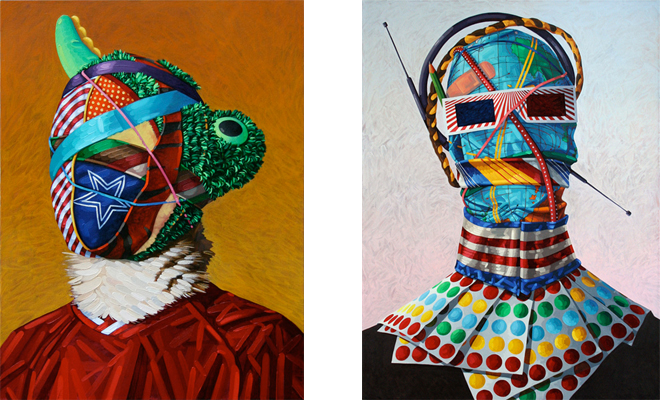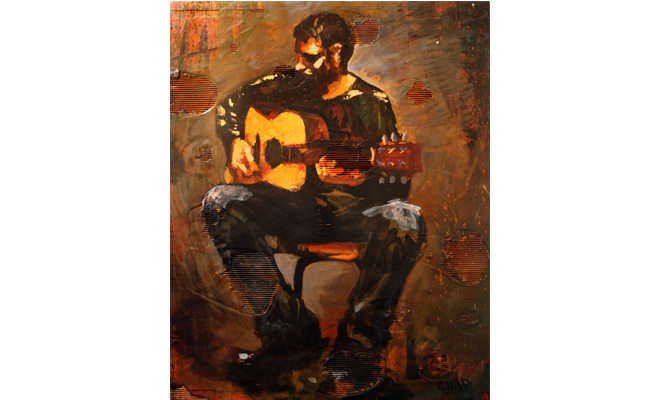Last Call: Chad Harris and John Harlan Norris at Du Mois Gallery

John Harlan Norris, Mascot, 2012 (left), and Foreign Observer, 2013 (right). Both oil on canvas. Courtesy the artist and Du Mois Gallery, New Orleans.
Editor's Note
Not only is it the last weekend to catch “Intorsion: Chad Harris and John Norris” at Du Mois Gallery, it is the gallery's last exhibition at their current address. Before it's gone, Tori Bush reviews.
Intorsion describes the inward rotation of a limb or organ, especially the eye when it’s twisted towards the midline of the face. Both John Harlan Norris and Chad Harris investigate inward-looking perspectives in this joint exhibition, though neither in the clinical sense. Norris reveals in bright colors and analytical brush strokes how social tasks define us. Harris’ work, heavy with dark emotion, suggests a more traditional and psychological approach to unpacking our social identities.
The daily practices of employment leave indelible, visible marks on a person. Someone who has sat at a desk for 20 years has a different physical presence than someone who has worked in construction. Norris’ paintings could be termed portraiture, but rather than focus on the physical characteristics of individual subjects, he relies on the instruments and attires that define the sitters' roles. Obscuring their unique traits, a jumble of textures and patterns wrap around the subjects’ heads. In Manager, 2011, striped ties suffocate the sitter, hiding any facial features, while Mascot, 2012, incorporates a mishmash of feathers, spikes, and a googly eye. By transposing traditional portraits into sociological composites, Norris questions how employment shapes the way we look at and perceive other people and ourselves.
In contrast to Norris’ vibrant, intricate works, Chad Harris, a set designer for Treme and other Louisiana film projects, imbues his work with a dramatic mood. Harris’ series consists of sculptural instruments, as well as figural paintings of guitar players and New Orleans landscapes. Each piece describes the tenor of the city—nebulous and rhythmic. There is something about Harris’ work that looks like time has exponentially moved faster, leaving a well-worn patina and a deep emotional residue on its surfaces. His impasto paintings of musicians are built on cardboard and he allows the material’s texture to show, as if the picture plane has rotted away. The wide and fuzzy brush strokes and sepia tones recall a memory from another time.
While each artist uses the tools of painting in distinct ways, both look at the events and practices that define our identity—our jobs, hobbies, and the cities where we live. By becoming a businessman or a guitar player, do our actions define our selves? Or is the passage of time a continuous and open pursuit for what we may become? John Harlan Norris and Chad Harris, when paired together, suggest that both questions should be taken into account.

Chad Harris, Guitarist 2, 2013. Acrylic on canvas and corrugated cardboard. Courtesy the artist and Du Mois Gallery, New Orleans.
Editor's Note
“Intorsion: Chad Harris and John Norris” on view until June 15 at Du Mois Gallery (4921 Freret Street) in New Orleans. The gallery is open Saturdays, 12–5 pm, and by appointment.
This fall Du Mois Gallery will open a larger exhibition space at 4609 Freret Street.



